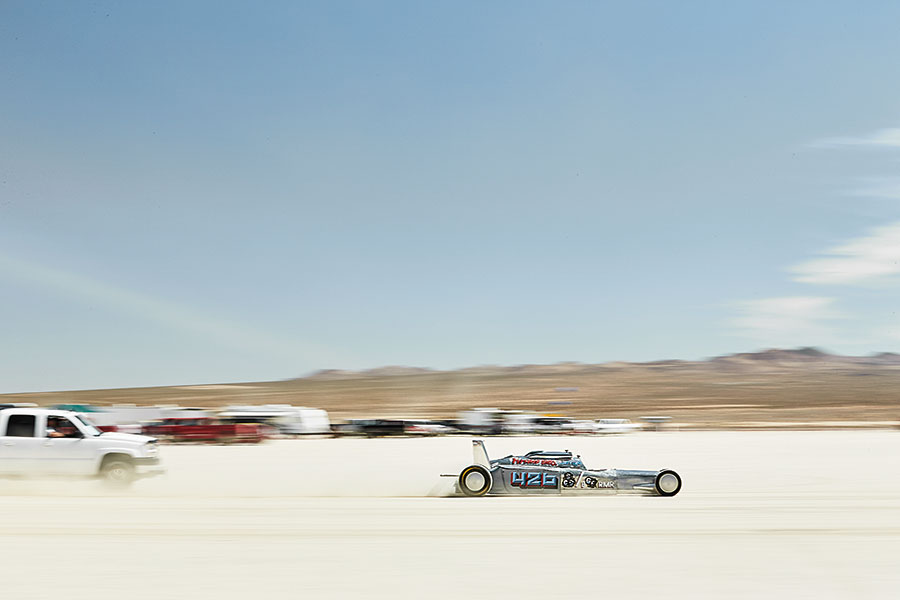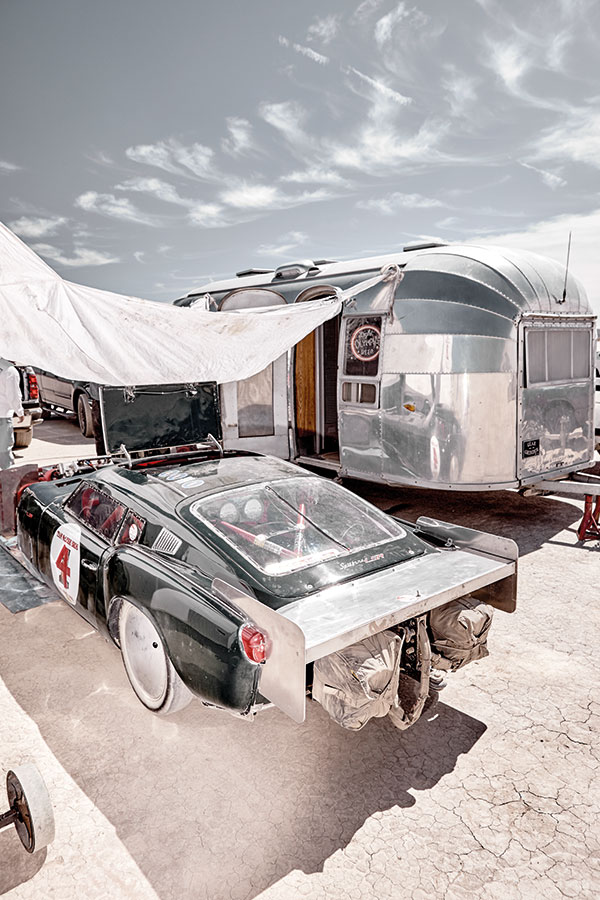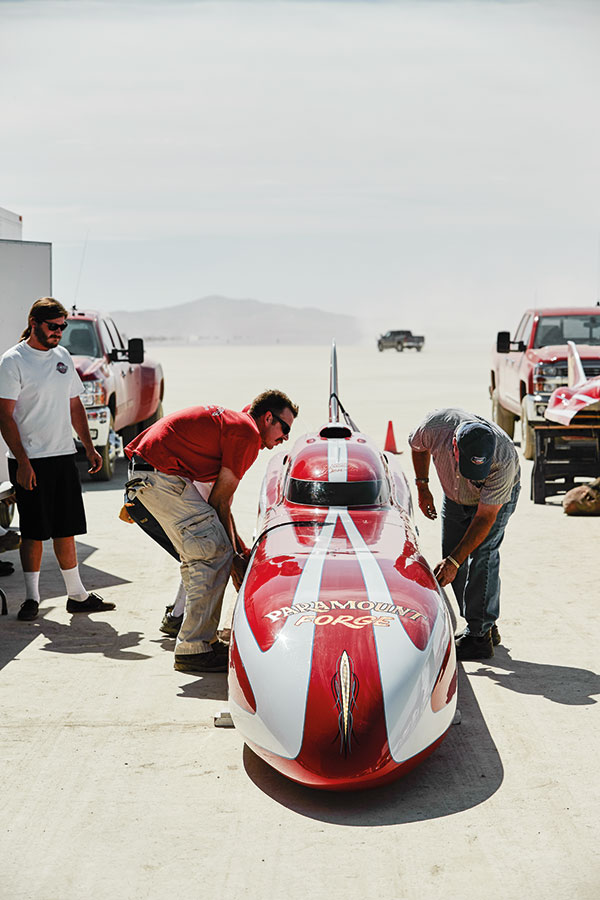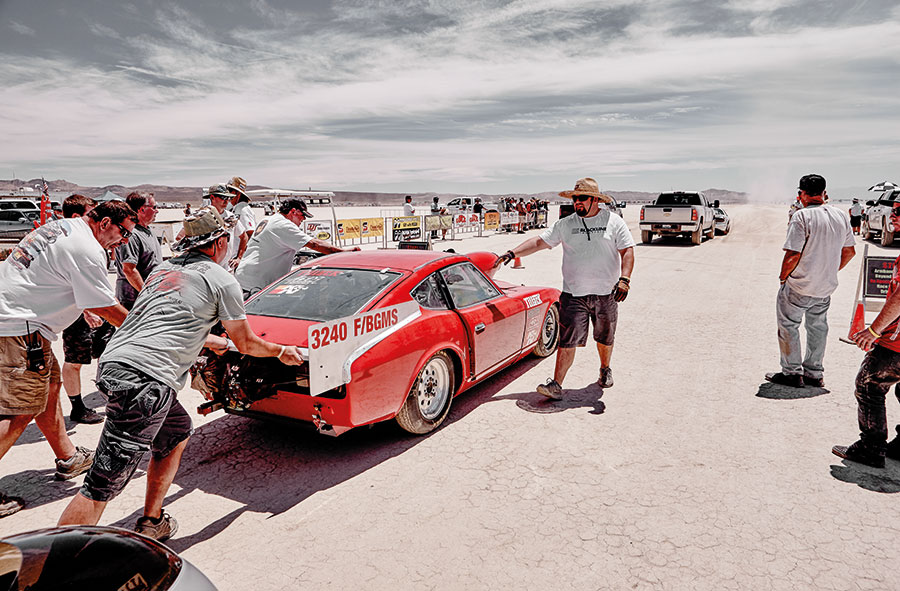California’s El Mirage dry lakebed has been home to speed runs for decades, and still holds six major events a year, with cars and bikes regularly topping 200mph. We just had to visit
Words: David Lillywhite. Photography: Matthew Howell. September 2015
 Some kind of sand creature, half man, half earthy elements, careers across the track on a machine that wouldn’t look out of place on the set of Mad Max. It’s all chassis tubes, suspension and dirt. Up ahead a ratty Henry J hot rod is kicking up a rooster tail of dirt, which we’re using as a direction marker. Without it we’d be completely and utterly lost on this vast plane of featureless, shimmering dry lakebed. Welcome to the El Mirage Off-Highway Vehicle Recreational Area. I’m not sure it should exist but I’m very pleased it does. The lakebed is used for speed runs, a lesser-known and marginally more hospitable counterpart to the Bonneville salt flats, while light aircraft and microlights are also permitted to land on the lakebed, and the surrounding mountains are a playground to quads, motocrossers, sand rails, dune bugs and mountain bikers. It’s very dusty and very hot.
Some kind of sand creature, half man, half earthy elements, careers across the track on a machine that wouldn’t look out of place on the set of Mad Max. It’s all chassis tubes, suspension and dirt. Up ahead a ratty Henry J hot rod is kicking up a rooster tail of dirt, which we’re using as a direction marker. Without it we’d be completely and utterly lost on this vast plane of featureless, shimmering dry lakebed. Welcome to the El Mirage Off-Highway Vehicle Recreational Area. I’m not sure it should exist but I’m very pleased it does. The lakebed is used for speed runs, a lesser-known and marginally more hospitable counterpart to the Bonneville salt flats, while light aircraft and microlights are also permitted to land on the lakebed, and the surrounding mountains are a playground to quads, motocrossers, sand rails, dune bugs and mountain bikers. It’s very dusty and very hot.
El Mirage is roughly halfway between Los Angeles and Las Vegas, 870m above sea level in the Mojave Desert’s hinterland of scrub, shabby houses and long-abandoned cars. It’s only a couple of hours out of LA but after a few miles of broken-up tarmac and missing signs, it’s easy to wonder whether the sat-nav has got it wrong.
And then at last there’s a sign, courtesy of the catchily named US Department of the Interior Bureau of Land Management, pointing us down a long, straight road with, incongruously, speed bumps every few hundred metres. At the end there’s a turn-off to the El Mirage visitor centre, where a $15 ticket allows access for a full day of madness, whether you’re a spectator, competitor or off-road lunatic. This is a relatively new development, along with a high, chainlink fence around the six miles long, two miles wide area.
Drive through the gates, down a short, bumpy slope and up ahead there’s a remarkable panormamic vista of almost nothing but nothingness, so vast and bright that eyes struggle to cope. Where to go? It seems sensible to keep well away from the wild-eyed off-roaders and follow the hot rods tearing across the hard earth. The baked silt surface is as unyielding as concrete and remarkably smooth but we don’t even try to keep up, relying instead on following the clouds of dust.
 Soon we can just about make out traffic cones and a few vehicles shimmering in the distance but there’s still something so disorientating about the featurelessness and the heat haze that we’re unsure whether we’re really going the right way. The cones and cars gradually loom larger in the windscreen, but our sunblinded eyes and jetlagged brains are still failing to work together to distinguish what’s what. Then, suddenly, we’re alongside the strip, just as a ’60s Oldsmobile shoots past, close enough to give us a clear view of the flames licking out from under the bonnet. A fire truck and ambulance follow in hot pursuit. Seems we’ve found the right place.
Soon we can just about make out traffic cones and a few vehicles shimmering in the distance but there’s still something so disorientating about the featurelessness and the heat haze that we’re unsure whether we’re really going the right way. The cones and cars gradually loom larger in the windscreen, but our sunblinded eyes and jetlagged brains are still failing to work together to distinguish what’s what. Then, suddenly, we’re alongside the strip, just as a ’60s Oldsmobile shoots past, close enough to give us a clear view of the flames licking out from under the bonnet. A fire truck and ambulance follow in hot pursuit. Seems we’ve found the right place.
The Oldsmobile pulls up and the driver jumps out, but the fire is already under control. We drive on, past increasing ranks of RVs, trailers and competition vehicles and into the haphazard paddock. We climb out just as the place goes quiet – not for the two pale limeys staggering back under the force of the heat but in acknowledgement of the work that’s now going to be needed picking up fragments of supercharged V8 from the scorching lake floor before another run can take place.
A crash out there, at 150mph-plus, can’t possibly end well but the racers are predictably blasé.
Have I mentioned that it’s hot?‘It’s not too bad,’ says event official Steve Davies, as we seek shelter under the awning of the scrutineering trailer. ‘Sometimes it gets close to 120 degrees [Fahrenheit, of course] but there’s a breeze today.’ Could have fooled us. The fierce sun attacks from every angle, reflecting off the baked crust of the lakebed, from the shiny fittings of the myriad beige RVs, and most of all from the countless white ‘speed record’ T-shirts of varying vintages adorning just about everybody who’s not in race overalls or leathers.
A quick aside here: the most coveted T-shirts are of the 200mph Club, of which a competitor only becomes a member by beating a class record at over 200mph. Merely achieving 200mph is not enough here.
The history and atmosphere of the place hit as hard as the heat. There have been speed runs on the various Southern Californian dry lakes since the turn of the 20th Century – Muroc (now the site of the Edwards Air Force Base) was the first, starting off around the same time as racing on the salt flats at Bonneville, Utah, followed by Harper, Rosamund and then El Mirage – but it really took off in the late 1930s, helped along by the formation of the SCTA (Southern California Timing Assocation).
Back then, El Mirage would have attracted mostly road cars, four-cylinders and flathead V8s alike, with lights, ’screens and even suspension dampers removed to save weight, and engines tuned with aftermarket cylinder head conversions, to the point that cars were often identified simply by the make of their cylinder head.
El Mirage and the like later received another boost as ex-servicemen began to seek out new thrills after World War Two. Since then, the speeds have cranked up – a ‘Lakester’ achieved 312mph in 1999 and several bikes have topped 250mph – but the enthusiast nature has remained, with competitors more likely to be working from a beat-up day van than a slick pantechnicon.
 We wander around, taking hit-or-miss chances on who’ll be chatty, who won’t. As in any motor sport paddock, if the vehicle is running fine, the team will be happy to talk. If it’s not… well, out here in the desert, the blank looks seem all the more foreboding.
We wander around, taking hit-or-miss chances on who’ll be chatty, who won’t. As in any motor sport paddock, if the vehicle is running fine, the team will be happy to talk. If it’s not… well, out here in the desert, the blank looks seem all the more foreboding.
Most of the cars are vaguely classics of some sort, from the 1930s rods to the long, narrow single-seaters, but under the skin they’re packing the very latest technology, engineered to startlingly high standards.
Ferrari specialist and Pebble Beach restorer Steve Tillack is here with his Datsun 240Z. He takes off the bonnet to reveal a gargantuan turbo suspended above the Toyota 2JZ engine on a bed-of-snakes manifold, before retreating into the cool of his motorhome.
A few bays along is – wait for it – a Triumph GT6. It’s had a roof chop, and sports moon discs, huge tray spoiler and a parachute hanging out the back, but the surprise is the 300bhp Hayabusa engine and front-wheel drive. ‘Ever thought how nice it is to have the front wheels spinning and to know where you’re going?’ points out owner Doug.
The crew of Paramount Force were hoping for 200mph but, as its driver gets increasingly agitated (even losing his race boots for a while as nerves take over), it becomes increasingly clear that electrical gremlins will end play.
Close by, tuner Jimmy Stevens fettles White Lightning, a 1933 Austin that’s been running here since the 1950s. With its Ford V8 flathead converted to overhead valves, its best time is a remarkable 181.9mph. ‘Getting faster with old technology!’ one of the crew remarks. Nearly an hour after the Oldsmobile self-destructed, the strip is declared open with a joyous announcement from the commentator. Within seconds, and with a cackle of engines and a blast of nostril-burning, eye-stinging nitromethane, the speed runs start again.
Competitors line up in one of four lanes. Lane one is for 200mph-plus vehicles, lane two for odd-numbered race entries, lane three for even numbers, and lane four for rookies (who are looked after well by SCTA officials). The highest-geared cars are pushed off the line by their crews’ pick-up trucks, of varying vintage and condition; it looks odd but it’s the only way for these high-powered monsters to gain speed on the slippery surface.
 Each race-car engine stutters and splutters into its powerband, then suddenly finds its sweet-spot and roars away, leaving the pick-up to peel off to the side and head for the end of the strip. Within split-seconds the car will be hundreds of metres away, shrouded in dust, every gearshift amplified across the sand. Sometimes we hear the revs rising too quickly as the car breaks traction, and everyone watching holds their breath until a higher gear is found and the revs settle down again.
Each race-car engine stutters and splutters into its powerband, then suddenly finds its sweet-spot and roars away, leaving the pick-up to peel off to the side and head for the end of the strip. Within split-seconds the car will be hundreds of metres away, shrouded in dust, every gearshift amplified across the sand. Sometimes we hear the revs rising too quickly as the car breaks traction, and everyone watching holds their breath until a higher gear is found and the revs settle down again.
And that’s just the cars. The bikes are altogether more unnerving to witness, and when their revs rise, you know the rider is fighting for control as the rear wheel shimmies and spins across the powdery surface. A crash out there, at 150mph-plus, can’t possibly end well, though the racers are predictably blasé.
‘It’s all about how you crash,’ says the owner of a long, cigar-shaped dragster. ‘Our last crash was pure textbook: [the car] just rolled onto its side. You don’t wanna tumble!’ The strip is 1.3 miles long, at the end of which is a 132ft timing trap to log the speed; different from the flying mile or kilometre of salt flat racing. We watch more runs, listen to the untiringly excitable commentary and delve further into the machinery on display. Kawasaki-powered Subaru 360? Oh yes! The crews start to pack up, some happy, others mourning destroyed mechanicals.
A long-avoided visit to the stiflingly and stinkingly hot plastic Portaloo rounds off a day of scorching sun, deafening exhausts, blinding, choking dust storms and dubious hot dogs. We’re probably sunburnt, but who’d know under the layers of dirt. Photographer Matthew Howell looks back, wipes grit from his bloodshot eyes and says: ‘I think this is one of my favourite places on Earth.’ Mine, too.
For more from the historic car world, try Octane magazine.
Subscribe today and get 5 issues for £5, plus a FREE welcome gift.